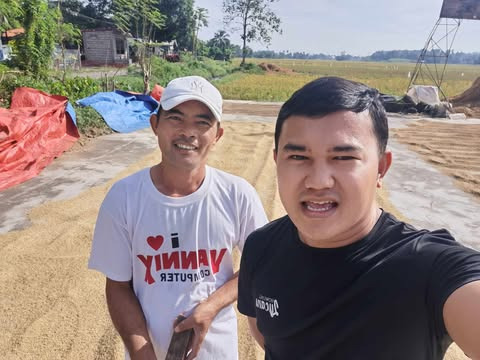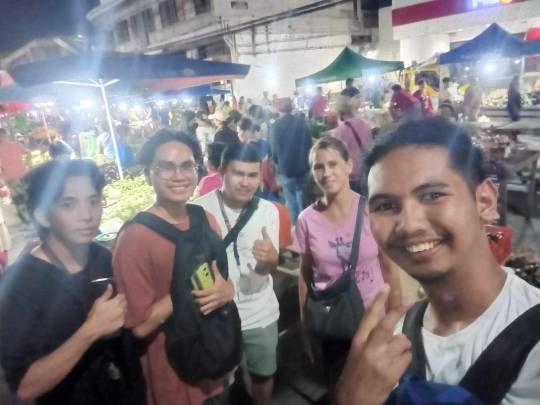Don't wanna be here? Send us removal request.
Text
The Real Struggles Behind Selling Crops in Rural Philippines
Farming is a way of life in Mahayag, Zamboanga del Sur, but one fraught with uncertainty. For farmers like Fe Gunob, Maria Clara Lumayaga, and Esteban Tagala, raising food is only half of the struggle. Selling it at a reasonable price, on schedule, and with trusted purchasers is typically the most difficult aspect. This post puts together the authentic voices of farmers from seven interviews, shining light on the ongoing issues of agricultural selling and pointing to potential solutions.
Pricing, Buyers, and the Gamble of Selling
Every harvest is a risk. The price of rice or corn can drop suddenly, especially when many farmers harvest at once. “Even if my harvest is of good quality,” said Fe Gunob, “others selling at lower prices often take away my potential buyers.”
Several farmers recounted how buyers change their minds or reduce their offers at the last minute. Danilo Ancis shared that a bulk buyer once backed out of a deal, forcing him to sell his ampalaya at a steep discount.
Worse, there's no assurance of long-term buyer relationships. Kent Legaspi noted that “some buyers don’t come back even after a good transaction.”
A Necessary Loss
Middlemen are common in rural markets and controversial. For those who can’t afford transport or don’t have direct market links, middlemen offer convenience. But the cost is high.
“They take a significant cut,” said Danilo. “Even though they sometimes help with transport, they don’t always give me the best deal.” Bebot Laguna echoed this, saying, “There’s really no room to negotiate when you’re in a rush to sell.”
Farmers who avoid middlemen often do so out of principle, not comfort. It means more effort, more transport stress, and more risk.
The Hidden Drain
Even with a good crop and a fair buyer, transport can make or break a deal. Vehicles break down. Rentals cost too much. Farmers like Raymund Ancis and Maria Clara Lumayaga have to work with limited setups like baskets on motorbikes or borrow trailers from relatives.
In one case, Fe Gunob spent more on fuel than she earned from selling. For others, like Esteban Tagala, a late payment from a mill caused weeks of financial stress.
Information Is Power, But Farmers Don’t Have It
The majority of farmers said they wish they had access to real-time market data, including buyer demand and pricing updates. Without it, they often overproduce, mistime harvests, or sell blindly.
“I wish I knew the expected demand for ampalaya in the area,” Danilo said. “That would help me plan my harvests better.”
Others expressed the need for weather forecasts, delivery schedules, and buyer reliability ratings, simple tools that could drastically improve planning and earnings.
Familiar Yet Underutilized
Many farmers use basic phones. Those who go online primarily use Facebook and YouTube for social updates or local news. Few use apps to support their farming business.
“I find Facebook useful because I can check for group buys or market trends,” said Danilo. Yet several interviewees noted feeling overwhelmed by too many posts and advertisements.
Language is also a factor. While some prefer English for navigation, most feel more comfortable reading and communicating in Cebuano or Tagalog.
Farmer Voices
Fe Gunob (59) – Sells rice directly to town buyers, avoids middlemen, but struggles with fuel costs and unreliable buyers.
Bebot Laguna (55) – Lacks internet access and uses referrals to sell; limited options and transport costs hurt profits.
Kent Legaspi (30) – Uses Facebook and tracks sales manually; wants real-time pricing tools.
Raymund Ancis (33) – Corn grower with his own truck, but high maintenance costs.
Danilo Ancis (54) – Grows ampalaya, sells to seasonal buyers; seeks demand forecasts and better transport access.
Maria Clara Lumayaga (54) – Sells cucumbers and rice at local markets; uses a motorbike and prefers Cebuano online.
Esteban Tagala (54) – Depends on rice mills; suffers from delayed payments and lacks internet.
What Can Be Done?
Farmers don’t need flashy apps or high-tech dashboards. What they want are:
Reliable price updates and demand forecasts
Buyer rating or feedback systems
Affordable, community-based transport
Simple, local-language platforms for trade
A space to connect with other farmers
The struggles they face are consistent, solvable, and urgent. Better systems both digital and cooperative could make a meaningful difference.
Listen, Then Build
What these interviews reveal is not a lack of effort or skill but a lack of support. Farmers are doing everything they can with the tools available. Now it's our turn to provide better ones.
As Fe Gunob said, “Even when we try our best, it doesn’t always pay off.” That shouldn’t be the case not for the people who put food on our tables.






0 notes
Text
Understanding Filipino Farmers’ Challenges in Selling Their Crops
In many parts of the Philippines, agriculture remains the backbone of rural life. Yet, for the farmers who feed the nation, selling their crops is often the most uncertain and stressful part of their work. This post brings together the lived experiences of seven farmers from different regions and walks of life, shedding light on the recurring struggles they face — and the opportunities we have to support them better.
Selling Crops Is an Ongoing Gamble
For many farmers, harvest season brings as much anxiety as it does relief. As farmer Anita Tumangob puts it, “Even if I go to the market early, there’s no guarantee I’ll find someone who values the effort I put into growing my crops.” Most farmers sell their harvest without knowing if they’ll earn enough to cover their costs, let alone make a profit.
Market prices are highly unstable and often drop during peak harvest times. Without access to real-time pricing or demand data, farmers are forced to accept low offers or risk watching their crops spoil. Anto Ancis, who grows perishable crops like ampalaya, recalls having to throw away spoiled produce because buyers didn’t show up in time.
The Middlemen Dilemma
While some farmers manage to sell directly in local markets, many are still at the mercy of middlemen — intermediaries who offer the convenience of pickup but at the cost of a fair price. Leonard Fuentes shares, “Middlemen take a big part of my income, but without them, I don’t have a way to sell, so I’m stuck with them.”
The consensus across interviews is clear: middlemen reduce farmer earnings and control pricing, yet many farmers lack the tools or networks to sell without them. Older farmers like Anita Ando and Cristita Mante rely on them out of necessity, highlighting the need for accessible alternatives.
A Costly Barrier
Transportation is another significant obstacle. Without their own vehicles, farmers must rent or borrow often at high costs and with uncertain availability. One missed delivery can mean a complete loss of income for the season.
Risalino Aranas notes, “Fuel is expensive now, and maintenance adds up too.” Several farmers suggested the need for community-shared transport services or more affordable access to logistics support tailored to smallholders.
Information Gaps and Pricing Transparency
One of the most consistent pain points is the lack of reliable information. Farmers repeatedly expressed the need for real-time updates on market prices and buyer demand.
“If I had access to updated market prices, I could negotiate better and avoid being underpaid for my hard work,” says Anita Tumangob. This gap leaves farmers vulnerable to opportunistic pricing and poor planning.
Record-Keeping and Financial Literacy
Most of the farmers interviewed keep handwritten notes to track income and expenses — if at all. Some admitted they don’t track earnings systematically and rely on estimates, which limits their ability to assess profitability or plan long-term.
Anto Ancis, one of the few who backs up his records with photos of receipts, is the exception. This reveals an opportunity to introduce simple, offline-compatible tools to help farmers manage finances more accurately.
Technology Use and Platform Preferences
Interestingly, the majority of farmers do not use dedicated agri-tech apps. However, many are familiar with Facebook and YouTube, using mobile data on basic smartphones to connect with others or watch farming videos.
When it comes to platform navigation, language matters. Most farmers prefer Tagalog or Bisaya for reading content, though some said English was easier to use in app settings due to better interface design. The need for local-language support in tech tools is clear.
Farmer Profiles
Here’s a brief look at who these farmers are:
Farm sizes range from 1.1 to 2.5 hectares.
Main crops: Rice dominates, with some growing ampalaya and corn.
Sales process: Some sell directly, while others rely on middlemen.
Transport: A mix of owned vehicles, rented trucks, and borrowed methods.
Tech use: None of the interviewed farmers use agriculture-specific apps.
Opportunities for Innovation
These interviews reveal specific areas where thoughtful technology and policy could create real impact:
Live price updates and buyer directories.
Community-shared transport scheduling apps.
Digital tools for record-keeping that are simple, visual, and offline-compatible.
Rating systems for buyer reliability.
Local-language user interfaces for non-English speakers.
Any solution must be co-created with the farmers it aims to serve. These tools don’t need to be flashy — they just need to be practical, accessible, and respectful of local realities.
Listening Is the First Step
From lowball offers to transport woes, from information gaps to unreliable buyers — these are not isolated incidents, but systemic challenges. Yet within these stories, there is also resourcefulness, perseverance, and a deep desire for fairness and dignity in trade.
“It’s like gambling because I don’t have access to real buyers,” says Cristita Mante. If we want to create a more just and sustainable food system, we need to ensure that farmers like Cristita aren’t forced to gamble their futures.







0 notes
Text
Listening to Our Users: Real Feedback That’s Shaping Our App
At the heart of any great digital product is the voice of its users. Recently, we sat down with several users from different age groups and backgrounds to hear their honest thoughts about our app. What we learned was insightful, encouraging, and—most importantly—actionable. Here’s a look at what they had to say and how we're planning to improve.
Performance & Navigation
Jennefer (35) pointed out slow loading times and the lack of a clear "Back" button. This made navigation feel disorienting at times. Smooth transitions and intuitive navigation are essential, and we’re prioritizing optimizations that ensure faster loading and better page control.
What we're doing:
Improving server response times
Adding consistent navigation tools like a persistent "Back" button
Accessibility & Readability
Elgine (46) expressed concerns about small text sizes. For older users, readability is not a luxury—it’s a necessity.
What we're doing:
Adding a font size adjustment feature
Implementing better contrast and readability options in the settings
Onboarding & Guidance
Luwena (39) shared her initial confusion with the app. Without clear instructions, getting started can be a challenge, especially for less tech-savvy users.
What we're doing:
Introducing a quick-start tutorial for new users
Adding tooltips and help icons for easier learning
Product Imagery
Honey (35) highlighted the importance of clear, large product images, especially when dealing with perishable goods like fruits and vegetables.
What we're doing:
Allowing users to upload higher-resolution images
Enabling zoom functionality on product photos
Mobile Responsiveness
Dennis (40) noted that the app doesn’t always display well on mobile devices, which limits usability on smaller screens.
What we're doing:
Implementing responsive design for seamless experience across all screen sizes
Testing layouts across multiple mobile devices
Posting Confirmation
Nestor (45) felt unsure if his product listings had been successfully submitted due to lack of feedback.
What we're doing:
Adding a clear confirmation message after each successful post
Including optional email or in-app notifications
Cart Stability
Melanie (42) found that items she added to her cart would sometimes disappear, disrupting her shopping experience.
What we're doing:
Ensuring the cart state is saved even after navigating away or closing the app
Adding a session-based memory to preserve user actions
Moving Forward
These suggestions are more than just feedback—they’re roadmaps. Each voice helps us see where we can do better, and we’re deeply grateful to all who took the time to share their thoughts.
Your experience matters. As we continue refining the app, your insights will remain our compass.
Have suggestions of your own? We’re listening. Contact us anytime or join our next user feedback session.



0 notes
Text
User Feedback Reveals Opportunities for Improving Our App Experience
Creating an exceptional user experience means listening to the people who matter most—our users. Recently, we gathered feedback from a group of users ranging in age and background. Their insights have shed light on both strengths and areas that require immediate attention. Here’s a summary of what we learned:
Major Pain Points Identified
1. Account Creation and Login Issues
Several users struggled during account creation. One user reported an error stating, “The email is already in use by a different account,” even though it was their first time using the app. Login functionality issues like these hinder onboarding and lead to frustration.
2. User Interface and Visual Clarity
The app’s current color theme—particularly the overuse of green—was criticized for being visually unappealing and even disruptive to readability. One user remarked that the design made it “hard to focus and navigate the interface effectively.”
3. Functionality Bugs
From unresponsive buttons in the cart to being unable to post a product or proceed to checkout, several users faced core functionality issues. One pointed out the inability to adjust product quantities or interpret confusing number formats, suggesting the use of commas for clarity.
4. Communication with Sellers
There is strong interest in clearer buyer-seller interaction. Users want to message sellers to confirm product legitimacy, availability, and delivery feasibility. Trust and transparency are top concerns.
5. Keyboard Obstruction
One user noted that the keyboard blocks the input fields during sign-up, making it hard to see what they are typing. This usability flaw is a common mobile UX issue that should be prioritized.
What’s Working Well
Not all feedback was negative. One user praised the site’s simplicity and intuitive navigation. They appreciated the clarity of the fonts and the layout’s straightforwardness. Another user expressed trust in the pricing transparency, which they felt came from a reliable source.
Takeaways for Improvement
Fix account creation/login bugs immediately to reduce user drop-off.
Redesign the color palette to improve contrast and reduce eye strain.
Ensure all interactive elements (buttons, fields) function smoothly across devices.
Improve seller verification and messaging systems to enhance trust and communication.
Refine input UI to avoid keyboard overlap and improve visibility on smaller screens.
Final Thoughts
User feedback isn’t just criticism, it’s a roadmap for creating a better product. These insights will guide our next design and development cycle as we continue to strive for an experience that’s both beautiful and functional. Thanks to all who shared their honest thoughts!



0 notes
Text
Navigating the Challenges of Buying and Selling Fresh Produce
Fresh produce is the backbone of many small businesses, from market vendors to restaurant owners. However, ensuring a steady and high-quality supply comes with its own set of challenges. Our latest insights, drawn from interviews with small business owners, highlight the difficulties they face and potential solutions for a more efficient market system.
Challenges Faced by Farmers and Buyers
For Farmers:
Selling produce isn’t always straightforward. Farmers often struggle with:
Finding buyers – Connecting with consistent and reliable buyers can be difficult.
Market access – Some farmers face barriers in reaching markets where they can get fair prices.
Choosing sales channels – Deciding between direct sales and middlemen can impact profits and efficiency.
For Buyers:
Buyers, including market vendors and restaurant owners, encounter hurdles such as:
Quality control – Ensuring fresh and high-quality produce requires careful inspection.
Supply inconsistency – Some days, suppliers have stock, while on others, they don’t.
Price fluctuations – Unstable pricing affects business profitability.
Delivery delays – Late or missing deliveries disrupt business operations.
Voices from Small Business Owners
We spoke to several small business owners about their experiences in sourcing fresh produce. Here’s what they had to say:
Quality Matters
Many business owners prioritize quality when selecting produce. Maricel, a small business owner from Carmen, emphasizes: “If it doesn’t look fresh, I won’t buy it.” Ebony from Agora Market agrees: “I always touch and smell the produce before buying.”
Challenges with Supply and Pricing
Supply shortages and price instability are major concerns. Angelica Ramos from Cogon shared: “The prices change often, and sometimes the quality isn’t what I expect.” Rodora Bragat from Lapasan added: “Seasonal shortages make it hard to maintain stock.”
The Importance of Reliability
While price is a factor, many business owners prioritize reliability. Jing from Agora Market explains: “Price is a factor, but I value reliability more. I’d rather pay a bit extra for consistent quality.” Alvin Reyes from Lomboy Indahag echoes this sentiment: “It’s important, but quality and consistency matter more.”
Potential Solutions for a Smoother Buying Process
Based on our interviews, here are some ways to improve the fresh produce market for both farmers and buyers:
Pre-order systems – Allowing buyers to place orders in advance can help farmers plan better.
Online stock updates – Providing real-time updates on stock availability would prevent unnecessary trips to markets.
Guaranteed delivery times – A reliable logistics system could reduce delays and ensure fresh produce reaches buyers on time.
Automated inventory tracking – Businesses like Rodora’s could benefit from an automated system that tracks stock and restocks when needed.
A digital marketplace – An app where farmers and buyers can connect directly would streamline the process.
The Future of Fresh Produce Trading
A more connected and transparent supply chain is the key to overcoming these challenges. Whether through digital tools or improved logistics, a system that benefits both farmers and buyers will create a healthier, more sustainable marketplace.




0 notes
Text
The Challenges of Buying and Selling Fresh Produce: Insights from Small Business Owners
Fresh produce is the backbone of many small businesses, from local eateries to food stalls and markets. However, both farmers and buyers face significant challenges in ensuring quality, affordability, and availability. In a recent set of interviews with small business owners, we gathered insights into the struggles and solutions that shape their daily operations.
Challenges Faced by Buyers
Small business owners rely heavily on fresh produce to maintain the quality of their products. However, many encounter obstacles, including:
Inconsistent Quality – Buyers ensure freshness by inspecting produce personally or sticking with trusted vendors. Yet, factors like transportation and handling can impact quality.
Supply Delays and Shortages – Many interviewees reported instances where they had to alter their menu or sell lower-quality products due to supply inconsistencies.
Fluctuating Prices – Sudden price changes make it difficult for businesses to maintain affordable pricing for their customers.
Reliability of Suppliers – Late deliveries and stock unavailability create disruptions in business operations.
Time Constraints – Many buyers struggle with the inconvenience of sourcing produce daily, especially when markets are far from their businesses.
What Would Improve the Buying Experience?
Based on the interviews, small business owners suggested several improvements to make the process more efficient:
Real-time Price and Stock Updates – Many buyers wish they could check prices and availability online before heading to the market.
Reliable Supply Chains – A dependable delivery service would reduce travel time and ensure businesses get the produce they need on time.
Pre-Ordering System – Some business owners prefer the ability to pre-order and pick up fresh produce without waiting in long lines.
Stable Pricing – Predictable pricing would help businesses plan their costs and maintain affordability for customers.
Key Takeaways from the Interviews
Here are some insights from the business owners interviewed:
Rose Marie (Small Business Owner, Lapasan CDOC): Trusts a consistent vendor for fresh produce but struggles with unreliable deliveries.
Neneth (Small Business Owner, Bugo CDOC): Prices are a top concern, as they impact how much she can charge customers.
Ricardo Lopez (Small Business Owner, Indahag CDOC): Prioritizes freshness over price and avoids shortages by buying early.
Marites Villanueva (Carinderia Owner, Bugo CDOC): Finds it frustrating when vegetables are already wilted by the time she gets to the market.
Rosa Lim (Small Business Owner, Lapasan CDOC): Faces issues with unpredictable pricing, leading her to search for cheaper alternatives.
Alvin Mendoza (Small Business Owner, Lapasan CDOC): Focuses on reliability since fresh produce is a daily necessity for his business.
Roberto Dela Peña (Food Stall Owner, Lapasan CDOC): Would benefit from an online system that shows real-time prices and stock availability.
A Call for Better Market Solutions
The challenges faced by these small business owners highlight the need for improved market structures. Technology can play a key role in making fresh produce more accessible and affordable. With better communication between farmers and buyers, stable pricing, and reliable supply chains, both parties can benefit from a more efficient marketplace.




1 note
·
View note
Text
Challenges and Solutions in the Fresh Produce Market: Insights from Farmers and Buyers
The fresh produce market is an essential component of the food industry, connecting farmers and business owners to supply fresh ingredients to consumers. However, both farmers and buyers face unique challenges that impact their businesses. Through interviews with food business owners and farmers, we uncover the key difficulties in selling and purchasing fresh produce and explore potential solutions to improve the supply chain.
Challenges Faced by Farmers
Farmers play a crucial role in the fresh produce market, yet they often struggle to find buyers and secure fair prices for their goods. Some of the key concerns they highlighted include:
Market Access Issues: Many farmers face difficulties in reaching potential buyers, often relying on middlemen who take a significant share of their profits.
Pricing Struggles: Without direct access to buyers, farmers may have to sell at lower prices, reducing their earnings.
Supply Chain Delays: Finding consistent buyers can be challenging, leading to delays in selling perishable produce and potential losses.
Potential Solutions:
Establishing direct connections with buyers through online marketplaces or cooperative selling.
Setting up local farmers’ markets to provide more selling opportunities.
Encouraging government programs to support fair pricing for farmers.
Challenges Faced by Buyers
On the other side, food business owners, such as restaurant and catering service operators, also experience difficulties in procuring fresh produce efficiently. Their concerns include:
Quality Assurance: Ensuring freshness and quality requires personal inspection, which can be time-consuming.
Availability Issues: Stock inconsistencies can lead to business disruptions and dissatisfaction among customers.
Pricing Fluctuations: Sudden price increases make budgeting difficult and may force business owners to raise menu prices.
Delivery Inconsistencies: Unreliable suppliers can cause delays and force businesses to make last-minute adjustments.
Potential Solutions:
Partnering with reliable suppliers who offer consistent stock and transparent pricing.
Implementing pre-order systems to ensure product availability.
Exploring digital platforms that provide real-time updates on prices and inventory.
What Farmers and Buyers Want
Through interviews with different stakeholders in the fresh produce supply chain, common themes emerged regarding what could improve the process:
Reliable Supply and Demand Connections: Farmers want direct access to buyers, while buyers seek consistent suppliers.
Transparent Pricing Models: Both sides benefit from fair pricing structures that promote profitability.
Better Logistics and Ordering Systems: Streamlined delivery services and online marketplaces can help bridge the gap between farmers and buyers.
The Future of the Fresh Produce Market
By addressing these challenges and implementing effective solutions, the fresh produce market can become more efficient and profitable for both farmers and business owners. Technology, better logistics, and stronger business relationships will play a key role in creating a more sustainable and reliable supply chain.




0 notes
Text
Challenges and Opportunities in the Fresh Produce Market: Insights from Farmers and Buyers
The fresh produce industry plays a crucial role in our daily lives, providing essential ingredients for households and businesses alike. However, both farmers and buyers face various challenges when it comes to selling and purchasing fresh goods. Through a series of interviews, we gathered insights from food business owners and market vendors about their experiences, struggles, and expectations in the fresh produce market.
Challenges Faced by Farmers and Buyers
For Farmers:
Farmers encounter numerous challenges when it comes to market access and selling their produce. Some key concerns include:
Difficulty in finding reliable buyers
The struggle between selling directly and using middlemen
Unstable pricing and seasonal fluctuations
Issues with transportation and logistics
For Buyers:
Buyers, including food business owners and market vendors, also deal with various problems, such as:
Inconsistent quality of produce
Delays and shortages in supply
The impact of price fluctuations on business operations
A need for better communication and real-time updates from suppliers
Key Insights from Food Business Owners and Vendors
We interviewed several food business owners and market vendors from different locations, and here are their valuable insights:
Ensuring Quality in Fresh Produce
Quality control is a top priority for all buyers. Here are some of their methods for ensuring freshness:
Rita Masion (Food Business Owner, Scions Kauswagan CDOC): Checks freshness, color, and aroma.
Janelle Ruiz (Food Business Owner, Iligan City): Examines texture, color, and smell; buys from trusted suppliers.
Marco Dela Cruz (Market Vendor, Cogon CDO): Sources from reputable farmers; checks freshness through color and texture.
Problems in Ordering Fresh Produce
Common issues include damaged goods, overripe produce, and inconsistent supply. For instance:
Antonette Reyes (Macapaya CDO) and Erick Nash Malferrari (Agusan CDO) both highlighted shortages and damages as major concerns.
Janelle Ruiz mentioned that wilted vegetables and overripe fruits upon delivery disrupt menu planning.
Marco Dela Cruz pointed out that improper handling during transportation leads to damaged goods.
Importance of Pricing
While quality is a priority, pricing remains a crucial factor in choosing suppliers:
Leah Malleguez (Bugo CDOC): Pricing affects the ability to sell at lower prices to customers.
Erick Nash Malferrari and Manelyn Suerte (Yakapin CDO): Emphasized the need for affordable yet high-quality produce due to inflation.
Marco Dela Cruz: Finds it challenging to balance pricing and profit margins while maintaining good quality.
Documentation:


0 notes
Text
Bridging the Gap: Challenges and Solutions in Fresh Produce Trading
The journey of fresh produce from farms to markets is riddled with challenges. Farmers and buyers alike face numerous hurdles, from transportation issues to unpredictable pricing. Understanding these struggles can help pave the way for more efficient and fair trade practices. This blog post explores the real-life experiences of farmers and food business owners, highlighting the key challenges and potential solutions in fresh produce trading.
Farmers’ Challenges in Selling Produce
Transportation Difficulties
For farmers like Nelfa Linano Tabornal from Bugo CDOC, transporting produce is a significant hurdle. She has to hire a horse to carry goods to the main road before reaching the market, increasing costs and reducing profits. Similarly, Mario Esconde from Talakag, Bukidnon, faces the challenge of waiting for traders to visit their area. If they don’t come, he has to make an expensive and time-consuming trip to the market himself.
Market Access and Unstable Prices
Many farmers struggle with market accessibility, particularly when natural barriers like rivers and rough roads disrupt their plans. Rosa Manayon from Claveria, Misamis Oriental, notes that market prices fluctuate unpredictably, making it hard to plan for a profitable harvest.
The Middleman Dilemma
Selling directly gives farmers more control over pricing, but it’s time-consuming and uncertain. On the other hand, relying on middlemen ensures sales but often results in lower earnings. Farmers like Mario Esconde find that while middlemen take away the stress of selling, they also take a large cut of the profits, limiting farmers’ negotiating power.
Challenges Faced by Fresh Produce Buyers
Ensuring Quality and Consistency
Buyers such as Erma Galla, a food business owner in Bulua CDOC, personally inspect produce to guarantee freshness. However, inconsistent supply makes it challenging to find quality ingredients regularly.
Transportation Issues
Transportation difficulties don’t just affect farmers—they also impact buyers. Mark Dela Cruz, a food business owner in Kauswagan CDOC, finds bulk purchasing for catering events difficult due to transportation constraints.
Impact of Delays and Shortages
Shortages can significantly impact business operations. Ryan Niek from Bulua CDOC mentions that when fresh produce is unavailable, he has to change his menu or find alternative suppliers, leading to customer dissatisfaction and reduced sales.
Potential Solutions for a More Efficient Supply Chain
Improved Transportation Infrastructure – Better roads and more reliable transport services would help both farmers and buyers reduce delays and lower costs.
Direct Farmer-to-Buyer Connections – Creating a system where farmers can directly connect with food business owners could eliminate unnecessary middlemen and provide fairer pricing.
Predictable Pricing Models – Establishing pricing guidelines or farmer cooperatives could help stabilize market rates, ensuring both parties benefit.
Supply Chain Digitalization – A platform for checking produce availability before market visits, as suggested by Maria Santos, could prevent time wastage and streamline purchasing.
Documentation:



0 notes
Text
The Challenges and Opportunities for Farmers at Cogon Market
Selling fresh produce at Cogon Market is no easy task. Farmers who own stalls face various challenges, from unpredictable demand to the physical strain of early morning setups. Through a series of interviews with local vendors, we gained insight into their struggles, selling methods, and potential opportunities for growth.
The Everyday Challenges Farmers Face
One of the most common difficulties among vendors is lack of sleep. Farmers must wake up extremely early to set up their stalls, which affects their health and energy levels. Unpredictable demand is another major issue some days, they sell out quickly, while on others, they’re left with unsold produce.
Additional challenges include:
Transportation problems – Delays or repairs can impact their ability to bring products to market.
Weather conditions – Rain can drastically reduce foot traffic, leading to poor sales.
Price competition – When multiple vendors sell the same produce, prices drop, reducing profitability.
How Farmers Find Buyers
Most farmers at Cogon Market rely solely on foot traffic. They don’t actively seek out customers; instead, they wait for market-goers to visit their stalls. Some vendors have loyal, repeat customers, but many struggle to attract new buyers.
The Preference for Direct Selling
Every interviewed vendor preferred direct selling over using middlemen. The main reason is control over pricing-by selling directly, they avoid losing profits to intermediaries. However, some farmers expressed openness to new opportunities if intermediaries could guarantee higher sales.
The Struggle with Market Access
Many farmers have faced situations where they had to lower their prices due to slow sales. Without access to a larger customer base, they remain dependent on daily market traffic. Some vendors are interested in selling to restaurants, supermarkets, or hotels, but they lack the necessary connections.
The Opportunity for Growth
To improve sales and financial stability, farmers could benefit from:
Partnerships with businesses – Selling to restaurants and hotels could provide a steady income.
Improved logistics – Better transportation solutions could help avoid delays and losses.
Marketing and outreach – Farmers could explore ways to attract more buyers outside of market-goers.
Documentations:



0 notes
Text
Transforming Apartment Searches and Agricultural Trade: Insight from User Interviews
Imagine the struggle of searching for the perfect apartment or ensuring that hardworking farmers get a fair price for their produce. At first glance, these challenges might seem worlds apart, but they share a common need convenience and transparency.
To uncover how technology is bridging these gaps, we spoke with seven individuals who have firsthand experience with two innovative platforms. One is HomeMatch, a rental-finding app designed to simplify the search for a new home. The other is AbotAgri, a digital marketplace that empowers farmers by connecting them directly with buyers. Their stories reveal how these platforms are reshaping the way we find homes and sustain livelihoods.
AbotAgri: Bridging the Gap Between Farmers and Buyers
For generations, farmers have toiled under the weight of an unfair system one where middlemen dictate prices, leaving them with meager earnings while consumers unknowingly pay inflated costs. It’s a frustrating cycle, but it’s the reality many farmers face.
When we spoke to respondents, their concerns painted a clear picture:
Unfair Pricing – Middlemen buy at rock-bottom prices and resell at a premium, widening the gap between those who grow the food and those who consume it.
Lack of Direct Access – Farmers struggle to reach businesses that could buy in bulk, forcing them to rely on intermediaries.
Technological Barriers – Many farmers, unfamiliar with modern digital tools, find it difficult to embrace online marketplaces.
But what if there was a way to change this? Enter AbotAgri, a platform designed to cut out the middlemen and connect farmers directly with buyers.
Respondents envisioned a marketplace where:
Fair Pricing empowers farmers with better earnings while offering consumers lower costs.
Bulk Purchases become seamless, helping businesses source fresh produce straight from the source.
Education and Support ensure that even the least tech-savvy farmers can navigate the platform with ease.
Key Insights
The “A-ha!” moment came when I realized that while removing middlemen could create a fairer system, success hinged on something even bigger helping farmers overcome the digital divide. A marketplace like AbotAgri could be the key to transforming agricultural trade, but only if farmers are equipped with the tools and knowledge to use it.
HomeMatch: Making Apartment Hunting Hassle-Free
Searching for the perfect apartment can feel like a wild goose chase especially when you're unfamiliar with the area, working with a tight budget, or sifting through outdated listings. It’s frustrating, time-consuming, and often leads to disappointment.
When we spoke to renters, they shared common struggles:
Unfamiliar Areas – Moving to a new place means not knowing where to start or which neighborhoods are safe and convenient.
Budget Constraints – Many listings within budget fall short of expectations, forcing renters to compromise or start their search all over again.
Outdated Listings – Scrolling through social media and rental sites often means encountering old or misleading posts, making it hard to trust what’s available.
But what if apartment hunting didn’t have to be this difficult? Enter HomeMatch, a mobile platform designed to take the guesswork out of finding a home.
Respondents envisioned an app that would:
Prioritize Convenience – A user-friendly interface with real-time listings would make searching effortless, particularly for students and professionals on the move.
Build Trust Through Transparency – Accurate, up-to-date listings with detailed descriptions, verified photos, and pricing would eliminate scams and false expectations.
Enable Remote Accessibility – The ability to explore apartments without multiple in-person visits would be a game-changer, especially for those moving from afar.
The “A-ha!” moment came when renters realized that trust and convenience go hand in hand. A platform that ensures real-time updates and detailed insights could revolutionize apartment hunting turning it from a frustrating task into a seamless experience.
Interviews Documentation
Interviewee: Maria Faith Gamayot

Interviewee: Febe Baconga

Interviewee: Ken Almerol

Interviewee: Jhon Vincent Tolosa

Interviewee: Lester Lee Lagamon

Interviewee: Xannie Justine Gabrinez

Interviewee: Franz Rey Bañez

The Future of Smarter Living and Fairer Trade
Whether it’s finding the perfect home or ensuring fair pricing for farmers, convenience and transparency remain at the heart of these challenges. Platforms like HomeMatch and AbotAgri show that technology can bridge critical gaps helping renters secure reliable housing while empowering farmers to take control of their earnings.
The key takeaway? A well-designed digital solution isn’t just about efficiency, it’s about creating trust, accessibility, and fairness in everyday transactions. As these platforms evolve, they have the potential to redefine industries, making life easier for both city dwellers searching for homes and farmers working tirelessly to feed communities.
The future is digital, and with the right innovations, it can also be smarter, fairer, and more connected than ever before.
0 notes